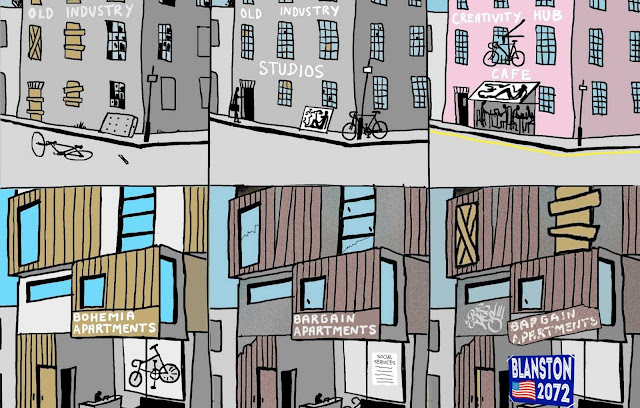'Pacification by cappuccino'
"Pacification by cappuccino" - Sharon Zukin
Todays class discussion really got me thinking about gentrification and all the affects it has on the people, place and culture of an area. The improvements of a building or a "bad" part of town seems to only be geared toward middle/upper class taste. This then forces the low-income people who have lived there for who knows how long out of their homes and makes them move to the outskirts of the city. I don't agree with these tactics. I do think it is good to renovate old, unused buildings or to try to bring in different business to bring more people to a specific area but I also think there should be a happy medium in doing that while not forcing the community that is currently there out. I understand that when renovating and bringing in new businesses that increases property values and so on but I wonder if there is a way to update a worn down part of town while also incorporating the existing community while bringing in new people.



I love the graphic you posted. I think seeing that life cycle of how buildings are used is very interesting when thinking about how quickly it could revert to somewhere undesirable. I think there is a way of incorporating the community but it's not easy and it's not done through the fast development that gets gentrification going in the first place. If an architect/developer's goal is primarily making money from a project, the community around it won't be better off. It is only when other factors of social context, economy, and population are considered that the revamping of an area can be done well.
ReplyDeleteI agree, the graphic you posted is super helpful. There is a life cycle of building use that can often not be planned for. Changing economies, cultural influences, and demographics make different areas fluctuate. This impacts buildings in ways it is impossible to know at the start of a project.
ReplyDeleteI agree with what you said. Being from Cincinnati, gentrification is a big conversation going on right now. It is an interesting issue especially for us as architects and it is so much more complex than what we can address so how we approach it can be tricky.
ReplyDeleteEquitable development is about more than getting the policies right; it is also about empowering stakeholders to outline the vision, implement the strategy, and monitor outcomes. A culture invested in participatory governing strategies is more inclined to take responsibility for the impact they make on their user group. In my opinion, gentrification can be geared towards positive outcomes by including all types of members throughout the design process and clearly defining benefits and consequences for each project proposed.
ReplyDelete